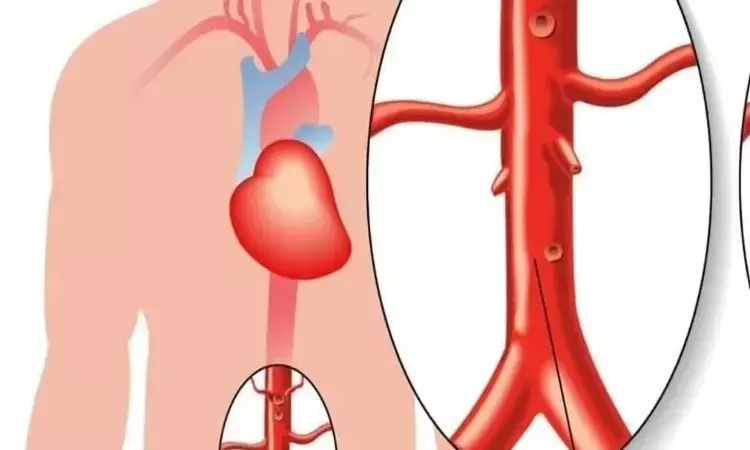- Home
- Medical news & Guidelines
- Anesthesiology
- Cardiology and CTVS
- Critical Care
- Dentistry
- Dermatology
- Diabetes and Endocrinology
- ENT
- Gastroenterology
- Medicine
- Nephrology
- Neurology
- Obstretics-Gynaecology
- Oncology
- Ophthalmology
- Orthopaedics
- Pediatrics-Neonatology
- Psychiatry
- Pulmonology
- Radiology
- Surgery
- Urology
- Laboratory Medicine
- Diet
- Nursing
- Paramedical
- Physiotherapy
- Health news
- Fact Check
- Bone Health Fact Check
- Brain Health Fact Check
- Cancer Related Fact Check
- Child Care Fact Check
- Dental and oral health fact check
- Diabetes and metabolic health fact check
- Diet and Nutrition Fact Check
- Eye and ENT Care Fact Check
- Fitness fact check
- Gut health fact check
- Heart health fact check
- Kidney health fact check
- Medical education fact check
- Men's health fact check
- Respiratory fact check
- Skin and hair care fact check
- Vaccine and Immunization fact check
- Women's health fact check
- AYUSH
- State News
- Andaman and Nicobar Islands
- Andhra Pradesh
- Arunachal Pradesh
- Assam
- Bihar
- Chandigarh
- Chattisgarh
- Dadra and Nagar Haveli
- Daman and Diu
- Delhi
- Goa
- Gujarat
- Haryana
- Himachal Pradesh
- Jammu & Kashmir
- Jharkhand
- Karnataka
- Kerala
- Ladakh
- Lakshadweep
- Madhya Pradesh
- Maharashtra
- Manipur
- Meghalaya
- Mizoram
- Nagaland
- Odisha
- Puducherry
- Punjab
- Rajasthan
- Sikkim
- Tamil Nadu
- Telangana
- Tripura
- Uttar Pradesh
- Uttrakhand
- West Bengal
- Medical Education
- Industry
DeBakey type I acute aortic dissection associated with high risk of in-hospital mortality: Study

The DeBakey classification divides Stanford acute type A aortic dissection (ATAAD) into DeBakey type I (D1) and type II (D2) according to the extent of acute aortic dissection (AAD). Patients with D1- acute aortic dissection had a higher risk of in-hospital mortality than those with D2- acute aortic dissection, suggests a recent study published in the Journal of Cardiothoracic Surgery.
Chun-Yu Lin et al from the Department of Medicine, College of Medicine, Chang Gung University, Taoyuan City, Taiwan conducted a retrospective study which aimed to compare the early and late outcomes of D1-AAD and D2-AAD through a propensity score-matched analysis.
The authors included a total of 599 consecutive patients, all of whom underwent acute type A aortic dissection repair at the institution and were dichotomized into D1 (n = 543; 90.7%) and D2 (n = 56; 9.3%) groups.
Propensity scoring was performed with a 1:1 ratio, resulting in a matched cohort of 56 patients per group. The clinical features, postoperative complications, 5-year cumulative survival and freedom from reoperation rates were compared.
The following findings were highlighted-
- In the overall cohort, the D1 group had a lower rate of preoperative shock and more aortic arch replacement with longer cardiopulmonary bypass time.
- The D1 group had a higher in-hospital mortality rate than the D2 group in overall (15.8% vs 5.4%; P = 0.036) and matched cohorts (19.6% vs 5.4%; P = 0.022).
- For patients that survived to discharge, the D1 and D2 groups demonstrated similar 5-year survival rates in overall (77.0% vs 85.2%; P = 0.378) and matched cohorts (79.1% vs 85.2%; P = 0.425).
- The 5-year freedom from reoperation rates for D1 and D2 groups were 80.0% and 97.1% in overall cohort (P = 0.011), and 93.6% and 97.1% in matched cohort (P = 0.474), respectively.
Hence, the researchers concluded that "patients with D1 acute aortic dissection had a higher risk of in-hospital mortality than those with D2- acute aortic dissection."
However, for patients who survived to discharge, the 5-year survival rates were comparable between both groups, they further added.
For further reference log into:
Lin, CY., Tung, TH., Wu, MY. et al. Surgical outcomes of DeBakey type I and type II acute aortic dissection: a propensity score-matched analysis in 599 patients. J Cardiothorac Surg 16, 208 (2021). https://doi.org/10.1186/s13019-021-01594-9
Dr. Nandita Mohan is a practicing pediatric dentist with more than 5 years of clinical work experience. Along with this, she is equally interested in keeping herself up to date about the latest developments in the field of medicine and dentistry which is the driving force for her to be in association with Medical Dialogues. She also has her name attached with many publications; both national and international. She has pursued her BDS from Rajiv Gandhi University of Health Sciences, Bangalore and later went to enter her dream specialty (MDS) in the Department of Pedodontics and Preventive Dentistry from Pt. B.D. Sharma University of Health Sciences. Through all the years of experience, her core interest in learning something new has never stopped. She can be contacted at editorial@medicaldialogues.in. Contact no. 011-43720751
Dr Kamal Kant Kohli-MBBS, DTCD- a chest specialist with more than 30 years of practice and a flair for writing clinical articles, Dr Kamal Kant Kohli joined Medical Dialogues as a Chief Editor of Medical News. Besides writing articles, as an editor, he proofreads and verifies all the medical content published on Medical Dialogues including those coming from journals, studies,medical conferences,guidelines etc. Email: drkohli@medicaldialogues.in. Contact no. 011-43720751


